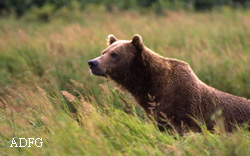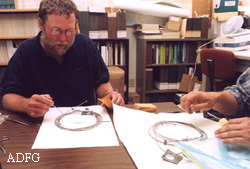Alaska Fish & Wildlife News
August 2008
Snaring Bear Hair
Low-Tech Snares Yield Valuable Insights

Visitors to Berners Bay north of Juneau may encounter odd bear traps this month - bear hair snares - at two popular camping and picnicking spots.
State wildlife biologists studying Berners Bay bears aren’t capturing the whole bears, just snagging bits of hair. Hair snares are set to collect samples from bears at six salmon streams. Four salmon streams are fairly remote and two are visited by anglers. The hair snares pose no threat to people; they simply collect bits of hair from passing animals. The hair follicle provides DNA, which reveals valuable information about the animals.
Biologist Ryan Scott with the Alaska Department of Fish and Game described the hair snare as a loop of cable set a few feet over a bear trail near a salmon stream.
“There are a few pieces of barbed wire clipped to the cable,” Scott said. “A bear sticks its head through the loop, which tightens and then breaks free. The barbed wire lies over the bears’ shoulders and collects a few clumps of hair, then lies on the trail. It’s a single catch, so we get hair from one bear.”
Scott said people can simply walk around the snares if they encounter them. Yellow signs labeled “Hair Collection Stations” are prominently placed in the areas to alert people.

The project began in the summer of 2006 and ran in 2007 as well. Snares will be up for about a month, from late July to late August.
People are most likely to encounter snares at Sawmill Creek. The creek, just a couple miles from the Echo Cove boat launch, is a popular stop for kayakers and boaters. The area offers good camping and a scenic waterfall about a quarter-mile upstream. Scott said there are a couple dozen snares at Sawmill Creek, from the intertidal zone up to the waterfall.
Biologists check and reset the snares once a week. Last year they saw only one bear, although there was abundant bear sign and lots of bear activity in the area.
“Most (snares) were getting hit, a very high percentage – 70 to 80 percent of the snares are encountered, and we get hair 50 or 60 percent of the time,” Scott said.
Results so far indicate a mix of black and brown bears. Black bears seem more abundant than brown bears near the intertidal areas, probably because they are more tolerant of human activity.
The results of genetic analysis will reveal the bears’ gender and species, as well as the relatedness between the bears, and help provide an estimate of the bear population in the area. Biologists are working to identify different bear populations, and understand the degree of mixing or inter-relatedness between bears from different areas.

“How unique are these bears relative to other populations around Southeast and Canada,” Scott said. “Have been they isolated for a significant amount of time? Do they have a unique genetic signature compared to the Chilkat Valley bears, or Unuk river bears?”
Scott said the answers could affect how bears are managed.
Biologist Rod Flynn said this year they may add Cowee Creek to the study area as well. The creek crosses the highway near the end of the road and is a popular salmon fishing stream for people and bears.
“There are quite a few brown bears on Cowee Creek,” Flynn said. “We knew there were black bears there but it seems there are a lot more brown bears using the area than we anticipated, especially above the bridge.”
Riley Woodford is a writer with the Alaska Department of Fish and Game. He edits Alaska Fish and Wildlife News and produces the “Sounds Wild” radio program.
Subscribe to be notified about new issues
Receive a monthly notice about new issues and articles.
